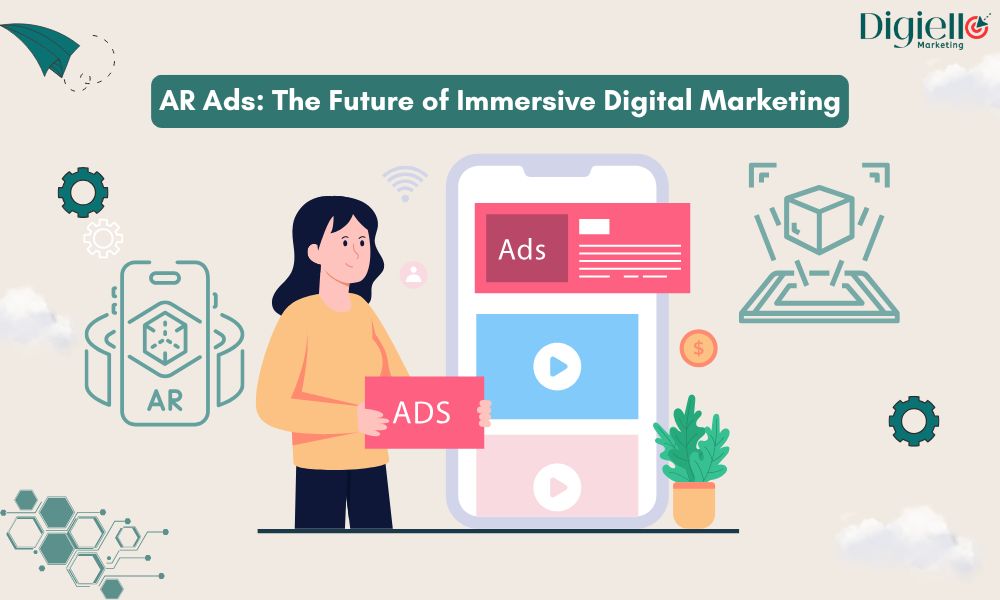AR Ads: The Future of Immersive Digital Marketing

The world of digital marketing is evolving at a rapid pace, and one of the most exciting advancements is Augmented Reality (AR) advertising. As technology continues to shape the way brands engage with their audiences, AR has emerged as a game-changer in creating more immersive and interactive experiences. In this blog, we will explore the future of immersive digital marketing through the lens of AR ads and how they are revolutionizing customer engagement, offering a deeper connection between brands and consumers.
What are AR Ads?
AR ads are interactive ads that incorporate augmented reality technology to enhance the consumer’s experience by blending digital elements with the physical world. Unlike traditional ads, which are static and passive, AR ads provide dynamic and engaging content that allows consumers to interact with the advertisement in a meaningful way. Whether it’s trying on virtual clothes, visualizing a new car in your driveway, or playing a game with your brand, AR ads offer a level of immersion that traditional advertising cannot match.
The future of immersive digital marketing lies in the ability of AR to create these unique, highly personalized experiences that captivate users and allow them to interact with the brand in real-time.
Why AR Ads are Future of Immersive Digital Marketing
1. Enhanced Customer Experience
At the heart of AR advertising is the customer experience. In an era where consumer expectations are higher than ever, AR provides an innovative way for brands to deliver value through engaging, interactive content. Traditional ads often rely on a “one-size-fits-all” approach, but AR ads allow for highly personalized and engaging interactions.
- Personalization: AR ads allow brands to offer highly personalized experiences based on individual preferences. For example, an apparel brand can let users try on clothes virtually before making a purchase decision, creating an experience that is tailored to the user’s needs and desires.
- Real-World Integration: AR blends digital content with the real world, providing a unique experience that traditional ads cannot offer. This integration enhances the user’s connection with the brand, resulting in deeper emotional engagement.
2. Increased Engagement and Interaction
With AR ads, brands can move away from passive advertising, where consumers simply watch or listen to an ad. Instead, consumers become active participants, engaging directly with the ad content. This interaction creates a memorable experience, increasing the likelihood that the consumer will remember the brand and make a purchase.
- Interactive Features: AR allows consumers to interact with digital elements in real-time, whether it's manipulating 3D models, exploring a virtual world, or playing a game related to the brand. These features keep consumers engaged and encourage them to spend more time with the brand.
- Gamification: By incorporating gaming elements, AR ads can become even more interactive, adding a layer of fun and excitement. Consumers are more likely to engage with ads that offer enjoyable experiences, increasing the overall effectiveness of the campaign.
3. Driving Brand Awareness and Recognition
In a crowded digital landscape, standing out is one of the biggest challenges for marketers. AR ads provide a unique opportunity to grab the attention of consumers in new and exciting ways. When a consumer interacts with an AR ad, they are likely to remember the experience, which leads to higher brand recall.
- Memorable Experiences: The future of immersive digital marketing hinges on creating memorable, shareable experiences. AR ads allow consumers to engage with brands in ways that are not only novel but also share-worthy, leading to organic brand exposure across social media and word-of-mouth.
- Viral Potential: Since AR ads are often fun and engaging, they have the potential to go viral. When users enjoy the experience, they may share it with their friends, further extending the brand’s reach and visibility.
4. Data-Driven Insights for Improved Marketing
AR ads are not just about creating visually stunning content—they also provide valuable data insights that help brands better understand their audience. Marketers can track how consumers are interacting with their AR ads, which elements they engage with the most, and how long they spend interacting with the content. This data can be used to optimize future campaigns, ensuring that each ad is more effective than the last.
- Tracking Engagement: By monitoring how users interact with AR ads, businesses can gain insights into which types of content or features generate the most engagement. This allows brands to refine their strategies for maximum impact.
- Behavioral Analytics: With AR, brands can collect detailed information about customer behaviors, such as which products they are most interested in or which experiences they are engaging with. This data helps brands improve their targeting and personalization.
The Role of AR Ads in the Future of Immersive Digital Marketing
As we look ahead, it’s clear that AR ads will play an essential role in the future of immersive digital marketing. The technology is still in its early stages, but its potential is vast. As mobile devices and AR glasses become more sophisticated, AR ads will become even more immersive and accessible, enabling brands to create even more compelling experiences for their customers.
1. The Growing Popularity of AR Devices
With the continued development of AR devices such as AR glasses and headsets, AR ads are poised to become even more prominent. These devices will offer an even more immersive experience by placing digital content directly in the user’s field of vision, creating a seamless integration between the physical and digital worlds.
- Wearable Technology: As AR technology evolves, it’s likely that AR glasses and other wearable devices will become mainstream. This will further enhance the effectiveness of AR ads, allowing users to engage with content in real time, wherever they go.
- Mobile Integration: AR ads are already available on mobile devices, but as smartphones continue to improve their AR capabilities, the reach of AR ads will expand. The future of immersive digital marketing will likely be mobile-first, enabling brands to deliver personalized, location-based AR experiences.
2. The Impact on E-Commerce
The integration of AR ads into e-commerce platforms is one of the most exciting aspects of this technology. Consumers will be able to virtually try on clothes, test out makeup products, and visualize how furniture will look in their homes—without leaving their living rooms. This capability will transform the online shopping experience and could increase conversion rates for e-commerce brands.
- Virtual Try-Ons: AR technology allows customers to try on products virtually before making a purchase decision. This helps reduce uncertainty and returns, making the online shopping experience more enjoyable and efficient.
- Interactive Product Previews: Consumers can interact with 3D models of products, getting a more realistic view of what they are purchasing. This leads to higher satisfaction and confidence in their purchasing decisions.
3. The Future of Advertising: AR Meets AI
As artificial intelligence (AI) continues to evolve, it will be integrated with AR ads to create even more personalized and intuitive experiences. By analyzing consumer data in real-time, AI can customize AR ads to individual preferences, making the advertising experience even more immersive and relevant.
- Dynamic Content Personalization: AI-powered AR ads will be able to adapt and change based on real-time user preferences, behaviors, and interactions. This dynamic content will keep consumers engaged and ensure that the ad resonates with them.
- Automated Campaign Optimization: AI will also be used to optimize AR advertising campaigns in real-time. By analyzing consumer behavior, AI will automatically adjust targeting, creative content, and ad delivery to maximize engagement and ROI.
How to Leverage AR Ads for Your Brand
1. Partner with the Right Digital Marketing Agency
If you're looking to integrate AR ads into your marketing strategy, partnering with an agency that specializes in immersive digital marketing is crucial. A best digital marketing agency like Digiello Marketing can help you create AR campaigns that are both creative and effective, ensuring that your brand stands out in a crowded digital marketplace.
2. Invest in the Necessary Technology
To succeed with AR ads, you’ll need to invest in the right technology. From AR development platforms to mobile apps and wearable devices, the tech infrastructure is essential to delivering high-quality, immersive experiences.
3. Experiment and Iterate
As with any new marketing strategy, it’s essential to experiment with different types of AR content and monitor performance. The future of immersive digital marketing will be shaped by trial and error, so be sure to test different approaches and iterate based on what works best for your audience.
Conclusion: The Bright Future of AR Ads
AR ads are set to play a pivotal role in the future of immersive digital marketing by creating highly engaging, interactive, and personalized experiences. As the technology continues to evolve, AR ads will become more accessible and integrated into consumers' daily lives. Brands that embrace this innovative approach will not only enhance their customer experience but also stay ahead of the competition in an increasingly crowded digital landscape. Whether you’re working with the bestSEO company in Delhi or exploring new ways to elevate your digital marketing strategy, AR ads are an exciting avenue for growth and engagement.
FAQs
What are AR ads?
AR ads are interactive advertisements that integrate augmented reality technology, allowing consumers to interact with digital elements overlaid onto the physical world.
How do AR ads improve the customer experience?
AR ads enhance the customer experience by providing immersive and personalized content that engages consumers in real-time, creating deeper emotional connections with the brand.
What is the future of immersive digital marketing with AR?
The future of immersive digital marketing with AR includes increased integration with wearable devices, AI-powered personalization, and enhanced Ecommerce experiences, creating more engaging and interactive ad content.
How can I integrate AR ads into my digital marketing strategy?
Partnering with the best digital marketing agency, investing in AR technology, and experimenting with different types of AR content are key steps in integrating AR ads into your marketing strategy.





